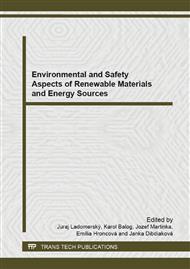[1]
Bill of NR SR Nr. 42/1994 Z. z. Civil security of citizens (information on: file: //C: /Users/Jozef%20K%C4%BEu%C4%8Dka/Downloads/zz2011-00045-0210111%20(2). pdf).
Google Scholar
[2]
Commission of the European communities, Critical infrastructure protection in the fight against terrorism. Brussels: (2004). ( information on: http: /europa. eu/legislation_summaries/justice_freedom_security/fight_against_terrorism/l33259_en. htm.
Google Scholar
[3]
RINALDI, S., M. at all: Identifying, Understanding and Analyzing Critical Infrastructure Interdependecies, IEE Control Systems Magazine, USA, (2001) ( inforamtion on: http: /www. ce. cmu. edu/~hsm/im2004/readings/CII-Rinaldi. pdf).
Google Scholar
[4]
Criteria for assignment of critical infrastructure element. (2010).
Google Scholar
[5]
BUTTON,K.: Transport Economics, Edward Elgar, USA, (2010), p.511.
Google Scholar
[6]
Keeping the Country Running: Natural Hazards and infrastructure, Cabinet Office, London, UK, (2011) (information on: www. cabinetoffice. gov. uk/ukresilience).
Google Scholar
[7]
Critical Infrastructure Resilience Strategy. Australian government, Canberra (2010), (information on: www. ag. gov. au/cca).
Google Scholar
[8]
GIANNOPOULOS, G., FILIPPINI,R., SCHIMMER,M.: Risk assessment methodologies for critical infrastructure protection. Part I., JRC European Commission, (2012).
Google Scholar
[9]
MOTEFF,J., at all: Critical Infrastructures: What Makes an Infrastructure Critical ? Congressional Research Service, USA, (2003), (information on: http: /www. fas. org/irp/crs/RL31556. pdf).
Google Scholar
[10]
SANTOS,J., HAIMES,Y.Y.: Modelling the Demand Reduction Input-Output (I-O) Inoperability Due to Terrorism of Interconnected Infrastructures, Risk Analysis, Vol. 24, No. 6, (2004) (information on: http: /www. ncbi. nlm. nih. gov/pubmed/15660602).
DOI: 10.1111/j.0272-4332.2004.00540.x
Google Scholar
[11]
HAIMES, Y.Y., LAMBERT, J.H., KAPLAN, S., PIKUS,I., LEUNG, F.: A Risk Assessment Methodology For Critical Transportation Infrastructure, Virginia Transportation Research Council, (2002).
Google Scholar
[12]
Internal information, Faculty of Civil Engineering, ZU in Zilina (2014).
Google Scholar
[13]
STN 736110 (2014) (information on: www. sutn. gov. sk).
Google Scholar
[14]
HDP (information on: www. portal statistics. sk).
Google Scholar
[15]
KLUČKA, J.: Approches to losses quantification due to disfunction of critical infrastructure. Proceedings from 17. scientific conference FSI, Zilina, (2012), pp.277-283.
Google Scholar
[16]
KLUČKA,J.: Critical Infrastructure and its Economy. In.: MEST Journal, Beograd, (2013), pp.1-7.
Google Scholar


